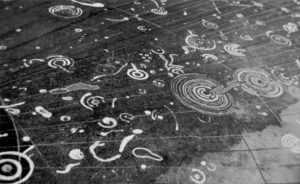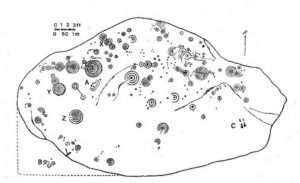 1
1

Arkaim and the texts of Rgveda about his builders
 25. 04. 2024
25. 04. 2024



 29. 07. 2018
29. 07. 2018

It will finally reveal the secrets behind it 5000 Year Old Cochno?
On the Cochno stone there are dozens of engravings similar to spirals, engraved depressions, geometric shapes and many types of mysterious patterns. The stone, dating from the Bronze Age, is located in West Dunbartonshire, Scotland, and is considered one of the most important preserved monuments in all of Europe. It is decorated with ornaments, which experts call rings and cups.
Until now, the stone had been buried for at least 50 years buried under a layer of soil and vegetation of several meters. At the time, it was a desperate attempt to save the stone from vandals. Nowadays, the famous stone is excavated once more and subjected to a thorough examination of the mysterious symbols in the hope that some of its secrets will be revealed. Archaeologists will use 3D imaging technology to create a detailed digital record of the surface traces found on the stone. He believes that this will "provide them with more information about the history of the stone, its purpose and the people who created it almost 5000 years ago."
The stone measures less than 13 x 8 meters. It was first discovered in 1887 by Pastor James Harvey in farmland on the outskirts of Clydebank. The land is currently owned by Faifley housing. The stone is covered with more than 90 engraved ornaments, known as 'rings and cups'.
The engravings of cups and rings are a form of prehistoric art, composed of a concave bend no more than a few centimeters across, are engraved into the surface of the stone, and often concentric circles appear all around, which are also engraved into the stone. The decoration appears similarly to petroglyphs on the surfaces of natural stones and megaliths, for example in small fortresses, stone circles and passage tombs. These are found mainly in northern England, Scotland, Ireland, Portugal, northwestern Spain, northwestern Italy, central Greece and Switzerland. However, similar ornaments can be seen around the world, including Mexico, Brazil and India.

Detail of cup and ring ornaments on Cochno stone. Acknowledgments: Royal Commission on the Ancient and Historical Monuments of Scotland.
The ornaments of cups and rings on the Cochno stone probably date from 3000 BC, along with them there is also an engraved pre-Christian cross inside the oval and two pairs of engraved footprints. Each fingerprint has only 4 fingers. Due to the number of ornaments found on the Cochno stone, it was given national importance, while it was declared and inscribed on the list of national monuments.
During the 60s, the Cochno stone was repeatedly destroyed by vandals and the people who walked on it. For these reasons, in 1964, archaeologists from the University of Glasgow recommended that the stone be buried to protect it from further destruction. Since then, the stone has been buried and is now covered with vegetation and trees grow around it.
The original meaning of ornaments on Cochno stone is definitely lost today, yet there are many theories that try to explain their original purpose. There are a wide range of hypotheses that say that this is an ancient form of writing, characters with religious and spiritual meanings. They can also be border markings, star maps, or simply decorative ornaments. For example, there may be some general opinion about the position of engraved stones, which can provide some clues to their function.

Map of petroglyphs on Concho stone. Image Source: The Modern Antiquarian. Selected picture: Stone is considered one of the most important preserved monuments throughout Europe dating from the Bronze Age. It is decorated with ornaments called "rings and cups". Acknowledgments: Royal Commission on the Ancient and Historical Monuments of Scotland.
Many carvings on the stones are located nearby or are incorporated into stone mounds and burial embankments. Therefore, symbols are associated in some way with funeral practices and most likely with faith, in which ancestors and the afterlife play a role. Symbols are also found on built stones and in stone circles. These are places that were formerly used for religious and ritual purposes. Engravings often appear on the surface of the stone with a very carefully chosen location, as if the place should provide a clear view of the surrounding landscape. Another view is that they correspond to the position of the stars, or that they are records of land ownership or a landmark.
Alexander McCallum, a history researcher who supported the idea of having the stone dug, said there were several versions of the interpretation of engravings.
"Some people think that the Concho stone is a map that shows other settlements in the Clyde Valley - one of many theories. "I think it served several different purposes, but it was never used for just one thing, but it changed its purpose over the centuries," McCallum added. "If we focus on the symbols themselves, some people believe that it is a portal of life and death, rebirth, womb and grave - people believed in reincarnation by leaving the earth and then coming out of it again."
Dr Kenny Brophy, an urban archaeologist at the University of Glasgow, the head of the excavations, hopes the new research will reveal more information about the ornaments and the people who created them.
Dr. Brophy says:
"It used to be well documented for archaeological research, but now we feel the time is right and we have the right technology to dig it up again and see what we can learn about new history and the people who created it."
Once the project is completed, the stone will once again be buried, and so will be preserved for future generations.